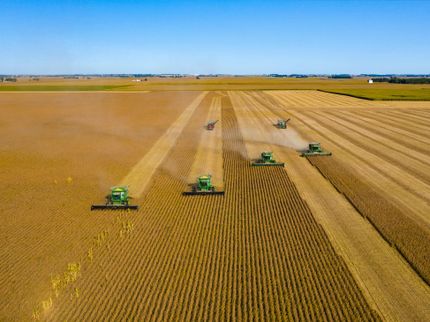Soybean production: a climate compatible with self-sufficiency on the European continent
Currently, Europe imports nearly 90% of the soybeans it consumes, mostly from the United States and Brazil, mainly for animal feed. Although the area under soybean cultivation has quadrupled on the continent in 12 years, from 1.2 Mha in 2004 to 5 Mha in 2016, it represented only 1.7% of total European cultivated area in 2016.

Photo of soybeans in hand
Pixabay
Yet local soybean cultivation has many economic and environmental advantages. Like other legumes, it fixes nitrogen in the soil thanks to symbiotic bacteria living in its roots, which is beneficial for the following crop and reduces the use of nitrogen fertilizers and their environmental impact. Moreover, the reduction of imports would reduce the cost and pollution associated with them. That is why researchers from AgroParisTech and INRAE set out to explore whether the European continent could become self-sufficient in soybeans, and whether climate change would be a help, or on the contrary, a hindrance, to this crop in Europe over the next few decades.
To do so, they developed a modelling approach based on the joint use of global agronomic and climatic databases and machine learning algorithms. Thanks to this, they were able to make continent-wide soybean yield projections directly from the available data, according to different crop area scenarios and based on forecasts of present and future climate conditions.
Self-sufficiency achievable with 11% of European cropland devoted to soy
The results show that the European agricultural area suitable for soybean cultivation is much higher than the area currently harvested. Projections indicate an average yield of 2 tonnes per hectare under current climatic conditions, even without irrigation or fertilizer, and it would increase with future climatic conditions by +0.4 to +0.6 tonnes per hectare in 2050 and 2090. Projections also show a shift of the most productive areas from the south of the European continent to the north and east due to climate change.
With a constant need for soybeans, the results suggest that soybean self-sufficiency of 50 to 100% is achievable in Europe, under current and future climates, if 4 to 11% of the cultivated land was devoted to soybeans. This would require an increase in crop area by a factor of 2 to 3, or 5 to 6, for a 50% or 100% self-sufficiency rate respectively. Assuming that fertilizers are not used on soybeans, this increase would cut back the use of nitrogen fertilizers by 4 to 17% on the European continent.
Original publication
Other news from the department business & finance

Get the food & beverage industry in your inbox
By submitting this form you agree that LUMITOS AG will send you the newsletter(s) selected above by email. Your data will not be passed on to third parties. Your data will be stored and processed in accordance with our data protection regulations. LUMITOS may contact you by email for the purpose of advertising or market and opinion surveys. You can revoke your consent at any time without giving reasons to LUMITOS AG, Ernst-Augustin-Str. 2, 12489 Berlin, Germany or by e-mail at revoke@lumitos.com with effect for the future. In addition, each email contains a link to unsubscribe from the corresponding newsletter.





























































